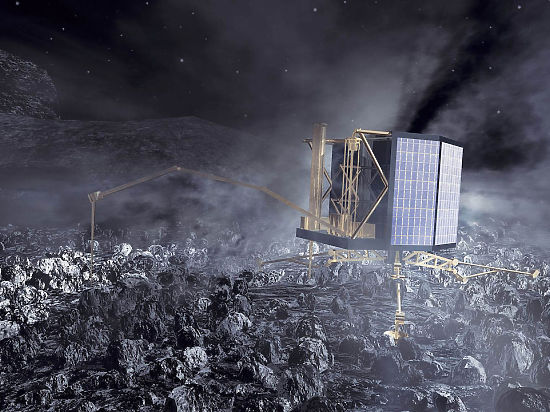Branch module of the spacecraft is scheduled for November 12
Yesterday at 19:58, Views: 24034
November 12 will truly historic event – the spacecraft to land on a comet. For the landing area on the comet P67 / Churyumov-Gerasimenko, which is planned to plant the descent module “Phil” spacecraft “Rosetta” scientists finally chose the name.

“Phil” on the surface of the comet (computer graphics: ESA / AOES Medialab).
At first, the site for planting, located on the “head” of the comet, designated as point J. Now it is called Agilkia (Agilkia) – in honor of the Egyptian island on the Nile River. To select the name was arranged open global competition. As a result of this week was sent about 8000 variants of the 135 countries. Curiously, the name Agilkia offered more than 150 members.
The name was chosen Agilkia jury composed of members of the Philae Lander, representatives of the European Space Agency and the German, French and Italian space agencies.
As the options were proposed site names in different languages, both ancient and modern, some were even in Esperanto. “There were also some interesting abbreviations curious sequence of digits and onomatopeicheskie options,” – said in a statement.
Всозданииаппарата«Фила»иегооборудованияпринялиучастие Austria, Finland, France, Germany, Hungary, Italy, Ireland, Poland and the United Kingdom. Russia, unfortunately, not on this list.
Weight lander “Phil” – 100 kg, informs wikipedia.org. The payload of the device is 26.7 kg and consists of ten scientific instruments: a detector of alpha particles and X-rays; combined gas chromatograph imass spectrometer for analysis of soil samples; a device for measuring the proportion of stable isotopes; 6 identical microcameras for panoramic shooting surface; CCD camera for filming during the descent; radar, called for imaging the comet’s nucleus; Sensors for measuring density, thermal and mechanical properties of the surface; magnetometer and plasma detector for studying the magnetic field of the nucleus of the comet and its interaction with the solar wind; 3 an instrument for measuring the properties of the outer layers of the comet; drill for extracting soil samples from depths of 0 to 230 mm.
«Rosetta” (weight 3,000 kg) – the first spacecraft, which entered orbit around the comet (established by the European Space Agency, and he went into space in March 2004). The device consists of two parts: the probe “Rosetta” (Eng. Rosetta space probe) and lander “Fila” (Eng. Philae lander). If successful, the next phase of the flight will be made the first soft landing on the surface lander comet. “Rosetta” in August, met with the comet Churyumov-Gerasimenko in November and landed on its surface research module “Phil” (Philae).
The name of the spacecraft comes from the famous Rosetta stone – stone slabs carved with her three identical in meaning of the text, two of which are written in the ancient Egyptian language (one – the characters, the other – Demotic), and the third is written in ancient Greek. Comparing the texts of the Rosetta Stone, scientists were able to decipher ancient Egyptian hieroglyphics; The space probe “Rosetta” scientists hope to learn how the solar system looked like before the planets formed.
The name of the landing vehicle associated with deciphering ancient Egyptian inscriptions. On the island of Philae on the Nile obelisk was found with hieroglyphic inscription mentions King Ptolemy VIII and Cleopatra II and Cleopatra III. The inscription, in which scientists recognize names “Ptolemy” and “Cleopatra”, also helped decipher ancient Egyptian hieroglyphics.
November 12 Rosetta perform the maneuver on the transition to the trajectory at which separation occurs lander. November 12 at 08:35 UTC, at a distance of approximately 22.5 miles from the center of the nucleus of the comet, Rosetta lander Philae will send a free flight. Planting will take place in seven hours, at about 15:30 UTC.
«Phil” will approach the comet at a speed of 1 m / s and fix on its surface using harpoons and ice Buravov. The first time the unit will operate at a pre-stored energy accumulators, which will continue to be charged by solar panels.
The average temperature of the surface of a comet for the first time after landing will be around -70 ° C. As we approach the surface temperature of the sun and the comet will rise inside the unit.
No comments:
Post a Comment